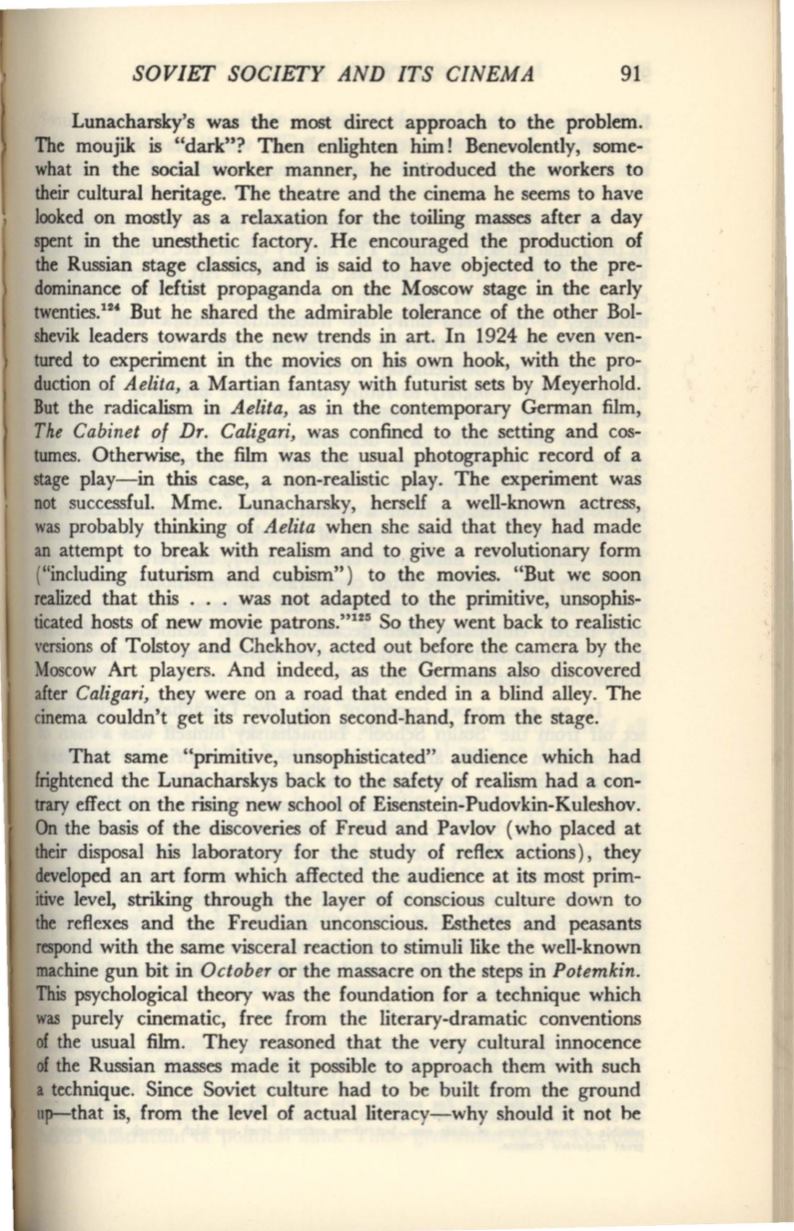
SOVIET SOCIETY AND ITS CINEMA
91
Lunacharsky's was the most direct approach to the problem.
The moujik is "dark"? Then enlighten him! Benevolently, some–
what in the social worker manner, he introduced the workers to
their cultural heritage. The theatre and the cinema he seems to have
looked on mostly as a relaxation for the toiling masses after a day
spent in the unesthetic factory. He encouraged the production of
the Russian stage classics, and is said to have objected to the pre–
dominance of leftist propaganda on the Moscow stage in the early
twenties.
m
But he shared the admirable tolerance of the other Bol–
shevik leaders towards the new trends in art. In 1924 he even ven–
tured to experiment in the movies on his own hook, with the pro–
duction of
Aelita,
a Martian fantasy with futurist sets by Meyerhold.
But the radicalism in
Aelita,
as in the contemporary German film,
The Cabinet of Dr. Caligari,
was confined to the setting and cos–
tumes. Otherwise, the film was the usual photographic record of a
stage play-in this case, a non-realistic play. The experiment was
not successful. Mme. Lunacharsky, herself a well-known actress,
was probably thinking of
Aelita
when she said that they had made
an attempt to break with realism and to give a revolutionary form
("including futurism and cubism") to the movies. "But we soon
realized that this . . . was not adapted to the primitive, unsophis–
ticated hosts of new movie patrons.m
25
So they went back to realistic
versions of Tolstoy and Chekhov, acted out before the camera by the
Moscow Art players. And indeed, as the Germans also discovered
after
Caligari,
they were on a road that ended in a blind alley. The
cinema couldn't get its revolution second-hand, from the stage.
That same "primitive, unsophisticated" audience which had
frightened the Lunacharskys back to the safety of realism had a con–
trary
effect on the rising new school of Eisenstein-Pudovkin-Kuleshov.
On
the basis of the discoveries of Freud and Pavlov (who placed at
their disposal his laboratory for the study of reflex actions), they
developed an art form which affected the audience at its most prim–
itive level, striking through the layer of conscious culture down to
the reflexes and the Freudian unconscious. Esthetes and peasants
rtspond with the same visceral reaction to stimuli like the well-known
machine gun bit in
October
or the massacre on the steps in
Potemkin.
This
psychological theory was the foundation for a technique which
was purely cinematic, free from the literary-dramatic conventions
of
the usual film. They reasoned that the very cultural innocence
of
the Russian masses made it possible to approach them with such
a technique. Since Soviet culture had to be built from the ground
UJr-that is, from the level of actual literacy-why should it not be


